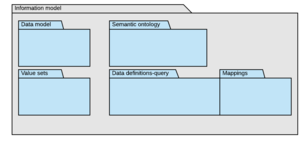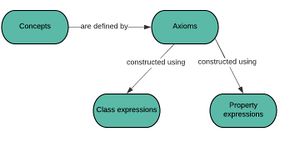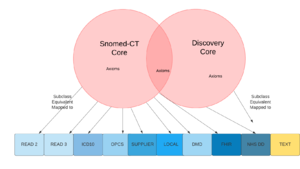Discovery health information model: Difference between revisions
DavidStables (talk | contribs) No edit summary |
DavidStables (talk | contribs) No edit summary |
||
| Line 6: | Line 6: | ||
# Direct use of the model data, either in a simple relational form, in one of the open standard representation syntaxes, or in the Discovery syntax | # Direct use of the model data, either in a simple relational form, in one of the open standard representation syntaxes, or in the Discovery syntax | ||
# Use via a set of APIs designed both to provide access to the data within the model, or to generate implementable data structures that use 1) and 2) | # Use via a set of APIs designed both to provide access to the data within the model, or to generate implementable data structures that use 1) and 2) | ||
__TOC__ | |||
<br />__TOC__ | |||
== Objectives of the Information models == | == Objectives of the Information models == | ||
Revision as of 11:40, 25 October 2020
Information modelling is the set of processes by which representations of data relationships are created and maintained. The Discovery models are designed both for human visualisation and for computers to use directly.
Implementations that use a model can use three approaches:
- Direct use of the model data, either in a simple relational form, in one of the open standard representation syntaxes, or in the Discovery syntax
- Use via a set of APIs designed both to provide access to the data within the model, or to generate implementable data structures that use 1) and 2)
Objectives of the Information models
The information models are sets of components designed as a contribution to achieving the following objectives:
- Enable people who are not technical experts to visualise and understand the structure and content of health records.
- Enable people who are technical experts to design systems based on the logical structure and content of the model
- Enable people to define the data they need in order to perform advanced analytics or decision support, in particular where the definition involves subsumption testing
- Enable query authors to have a library of value sets (sets of concepts) and query definitions for re-use across the health sector
The models are independent of implementation technology, i.e. they are abstract models, thus can be implemented in technologies of choice.
Business domains and domain types
A model is only relevant for a particular set of business purposes and here is no single model that can accommodate all business purposes, although common information models can accommodate quite broad purposes. A reasonably well understood set of business purposes is referred to in these topics as a "business domain" or "domain of interest" and a particular information model is designed to cover a business domain.
An example of a business domain might be patient related health characteristics, clinical management in General Practice, or commissioning in the English NHS. Domains may be specialised, for example a rapid access chest pain clinic can also be considered as a business domain. A common information model will generally include data relationships needed by many domains, arranged in a way that inconsistency or unreliability is avoided.
Discovery modelling covers two main types of Domain:
- A semantic based definition and classification of concepts used within a domain. These are ontologies and represented in a standards based way that supports advanced ontological techniques such as classification and reasoning. All concepts represented in a business domain will have a semantic definition in a semantic ontology. An ontology covering the health care domain would typically include Snomed-CT, commonly used classifications such as ICD, as well as bespoke system specific concepts used for business purposes. The Discovery common information model semantic ontology is a super-ontology of ontologies.
- Data models for business purposes. The term "business" includes the business of data recording for clinical purposes and thus covers commissioning, research, as well as clinical management and interoperability between systems. Data models may be derived from other data models. Other terms are frequently used such as a "data set definition" (which is a model of a data set) or a "content model", which is a specification for use in data exchange, but they all refer to the same thing.
The model building bricks
All the Discovery models, whether semantic models or business related data models are built using the same machine readable language. More specifically, the language grammars used are based on the following set of open standard based languages, interpreted in a way that matches the businesses:
- OWL2- Description Logic. The grammar is interpreted according to the domain type and us case. For example, when used for classification and reasoning the language is interpreted via the open world assumption i.e. standard OWL reasoners may be used. However, when used for decision support (such as checking whether two drugs interact), the closed world assumption is used. This converts the language into a multi-purpose language able to support negation and to remove undecidability (this being a necessary mental process in diagnosis and clinical judgement).
- SPARQL Query. Discovery uses a small subset of the language in order to preserve an easy direct mapping to SQL. It uses an OWL entailment regime of a kind that simplifies query by assuming subsumption unless otherwise specified.
- Attribute based Access control language which is specialised to include a vocabulary used to control access permissions. It maps precisely to XACML
Both OWL2 and SPARQL bring complexity with them and are not in themselves optimised for implementation using common technologies such as object oriented languages and relational databases. In order to address this problem Discovery has a pragmatic JSON based syntax which maps 1:1 to Manchester OWL syntax SPARQL and SQL. The syntax enables easier auto-generation of user interfaces, implementation classes and relational schemas.
Ontologies and modules
The Discovery common information model can be thought of as an ontology of ontologies. More precisely though it should be considered as an ontology consisting of a set of ontology modules with each module defined according to business needs. The principle of concept sharing, whereby one concept is identified once across the entire set of domains, suggests that there is a single ontology. However a data model that is specified for a particular business purpose may have different class structures from another business purpose even though they share the same semantic definitions.
For example, take the idea of recoding information about a blood pressure. This is an example of a component in a data model. In General practice, it would be common practice to record a systolic and diastolic blood pressure and thus the component would consist of 3 classes. However, in a specialist research study involving different interpretations of blood pressures, including perhaps the size o nature of the cuff, or the exact position of the patient, this component may be more complex.
This is addressed by modularisation where the axioms that define the classes belong to a particular model, even though the property domains and their ranges are shared across the ontology. This is analogous to the idea of templates derived from subsets of archetypes. The difference is that there is no "super-archetype" requiring international agreement on the items in the archetype, but instead there is a demand that the same identifier of the diastolic blood pressure record class is used throughout, even though the class definition is business specific.
Disambiguation of terms
Throughout the healthcare domain, the same terms are often used to mean different things when used in different contexts. This can create some fundamental problems in design, which the information modelling attempts to overcome.
Take a "blood pressure" as an example, this could be used mean :
a) The actual blood pressure observation itself (a blood pressure was observed)
b) The record of a blood pressure (Mrs Smith's blood pressure on 1st February),
c) The blood pressure procedure (A blood pressure procedure was undertaken).
This ambiguity is addressed by using different concept identifiers for the different contexts. Editorial policy would normally disambiguate the term e.g. blood pressure (observation), blood pressure measurement (procedure), or blood pressure (record).
The net result of disambiguation is the generation of many more identifiers for record based classes in the model. In the blood pressure example several identifiers are likely to be used to model the blood pressure related in the following way:
In the GP Domain Module a blood pressure data model might be:
Blood pressure (record) -> is a subclass of -> observation (record)
& -> is a record of -> a blood pressure (observation)
& -> has subcomponent- > [of systolic blood pressure (record),
and diastolic blood pressure (record)]
This creates a type hierarchy in the data model similar to the type hierarchy in the semantic model. From an implementation perspective it is likely that the "Observation" would be mapped to a table directly, whereas the blood pressure record would be assigned to a "record of" or "type" column, the content of which could be any object that is a member of the observation type value set, and 2 additional observations as components would be created. HL7 FHIR uses this model via the use of the generic term "code" and "component".
Unlike other frameworks such as FHIR or OpenEHR there is no health specific "Reference" model as such beyond the OWL standard need to differentiate classes from properties from data types. This is because a selected structure from the top down is determined by interpretation, use case and the communicating community.
Models viewed in packages
Another way of categorising the information models is by the use of the idea of packages.
Discovery information models can be said to reside within one of 5 packages, each package directed at particular sets of use cases. Two of the packages fall into the sematic ontology domain type, and 3 fall into the data modelling domain type.
Crucially, all the packages are integrated by a common language and share the same concepts, each of which are defined within a semantic ontology.
- The semantic ontology is the set of concepts used in all parts of the information model, from clinical concepts through to data structure concepts
- The data model is a set of entities, attributes and value sets, all of which are defined precisely in the ontology, but he data model, being created for a specific business of healthcare is separate to the ontology.
- Value sets , or concept sets, are business purposes specific collections of concepts from the ontology used in the data model or in query and contain concepts as defined in the ontology, using the ontology language, including advanced concept classes.
- Data set definitions apply rules and filters to a data model in order to specify the nature of the entries and their content required in a purpose specific data set
- Model maps specify how data is transformed from a data model to a particular database or messaging format.
- Data base schemas are reference schemas (RDB and maps) showing an implementation of a data model and data sets. Strictly speaking these are not part of the information model but are included as “proof of solution” of the model.
- Query definitions are a library of re-usable queries.
Semantic ontology
A semantic ontology defines the meaning of the concepts that make up the content of health records. The meaning is defined in a way that a computer can use to classify, reason and analyse.
As a semantic ontology is based on Description Logic, the semantic ontology applies the same interpretation to its concepts for classification as does OWL However when used for purposes such as authoring and value set generation, closed world assumption is used of the kind described in the Snomed expression constraint language.
The world leading Snomed-CT ontology forms the major part of the semantic ontology for the definition of health characteristics, supplemented by maps to the legacy concepts such as ICD10 o Read codes. Consequently the semantic ontology can be represented in several syntaxes including the mainn OWL syntaxes, Manchester Syntax, Snomed compositional grammar and Expression constraint language
An ontology is made of of a number of axioms which relate concepts to other concepts in a fractal like manner. T
The ontology may also be defined using the Discovery semantic ontology language, which is itself a syntactical simplification on the standard OWL2 language. The Discovery language exists in order to accommodate additional constructs not covered in OWL, namely data set definitions, value set definitions, and transactional messaging.
Relationship between core and legacy
The semantic ontology can be modularised into Core and Legacy concepts according to the namespaces of the concept identifiers. That is not to say that the legacy concepts are not used. Quite the reverse. Given that 99%+ of all healthcare data is still recorded using legacy concepts the semantic ontology must incorporate these. In addition a vast number of system specific or provider specific codes are in use.
Both core and legacy are defined by OWL2 DL axioms. However, the core concepts are likely to be defined in a way that sufficiently identifies the concept within the domain whereas legacy concepts are more likely to be defined only to the extent necessary for query subsumption. Nevertheless legacy concepts may also be sufficiently defined. In many cases those definitions come in the form of expressions containing core concepts.
For example, An adverse reaction to Atenolol is a GP legacy concept. This can be sufficiently defined in the following Axiom
Adverse reaction to Atenolol - is equivalent to - (Adverse drug reaction & causative agent = Atenolol)
The Discovery common model creates relationships between core and legacy using a mapping relationship, the commonest being
- Equivalent. Where the legacy code or term is deemed to be equivalent in meaning and definition to the core concept
- Subclass. Where the legacy code or term is deemed to be subclass of the core concept
- Mapped to. Where the legacy code would be expected to be a member of the set defined by the core concept, but may not be sufficiently defined to be confident of equivalence or subclass.
From a mapping perspective the maps operate from Core -> Legacy and not the other way round. For example, if one were searching for Diabetes using a core concept, and a patient had a diagnosis of the ICD10 code "Diabetes without mention of complication" then one would expect that patient to be found (depending on the enquirers preference). However, if querying on "Diabetes without mention of complication" then no core concept would be found as the relationship does not go forward. The exception to this rule is the "equivalent" axiom which is bidirectional.
If the relationship between a core and a legacy is "equivalent" or "subclass", this does not mean that the child codes of the legacy codes would normally be included, as the child codes are often not subclasses from a semantic perspective. This is important to recognise when authoring queries using core concepts, operating on data that uses legacy codes.
Value sets or concept sets or reference sets
Main article : Value_sets
A value set definition, and it's run time counterpart- value set transitive closure , is a set of class expressions collected together for a particular business purpose.
There are a range of purposes for a value set. Examples range from defining a data set according to a set of recorded concepts, indicating the expected range of a property in a health record, or testing the presence of a feature in a patient record.
Data models
Main article : Data Model
A data model is module of an ontology that defines classes required for particular business purposes.
Business purposes vary from the need to store particular items of data through the need to display items in a certain way. This is the model that defines the ever evolving structure of health records held within multi-domain health records, varying from common high level classes through to specialised classes. An example of the former is an 'observation', and an example of the latter is a 'Blood pressure' or an 'histological/immunological report on a breast carcinoma'.
N.B. in IS013606 these are called archetypes and their derivative templates. In FHIR they are referred to as resources and profiles.
Data definitions - query
Data set definitions or queries are a key component of the information model.
A data set definition is a specification of a subset of data derived from one or more data models
A data set definition, once established, can also be used as a source data model and thus data sets can be chained by placing a data set into the role of a data model.
A data set uses query like constructs to define its structures. Data set entities and data set attributes may be derived from a combination of ontology and data model query. To that extent, a data set definition can be said to use a query language.
The Discovery data definition language is not designed to operate as an actual query language, as it does not extend to include all the sophistication needed by a run time query language. For example, there are no optimisation techniques employed or references to the use of indexes. However, the language is sufficiently rich to be able to easily generate SQL or Cypher from the specification when used with a data model map to the implementation schema.
Data Maps
Data maps hold the maps for a variety of purposes, mainly being:
- Maps between the data model and an implementation schema to enable auto generation of query syntax such as SQL or CYPHER
- Maps between legacy data models and or their values to the common information models


